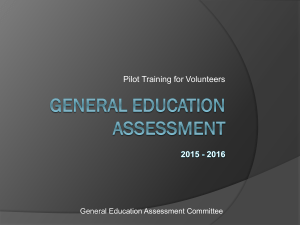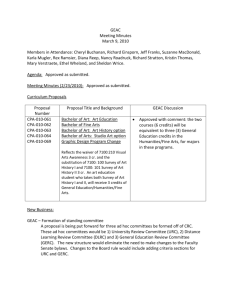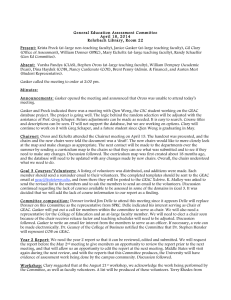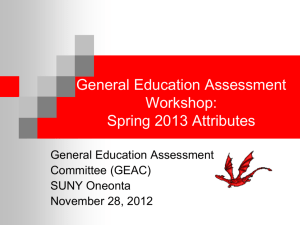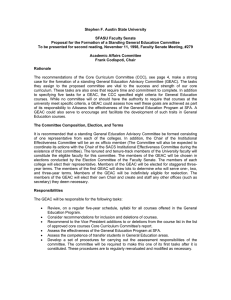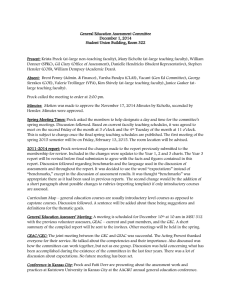GENERAL EDUCATION ASSESSMENT COMMITTEE (GEAC) AY 2012 - 2013
advertisement
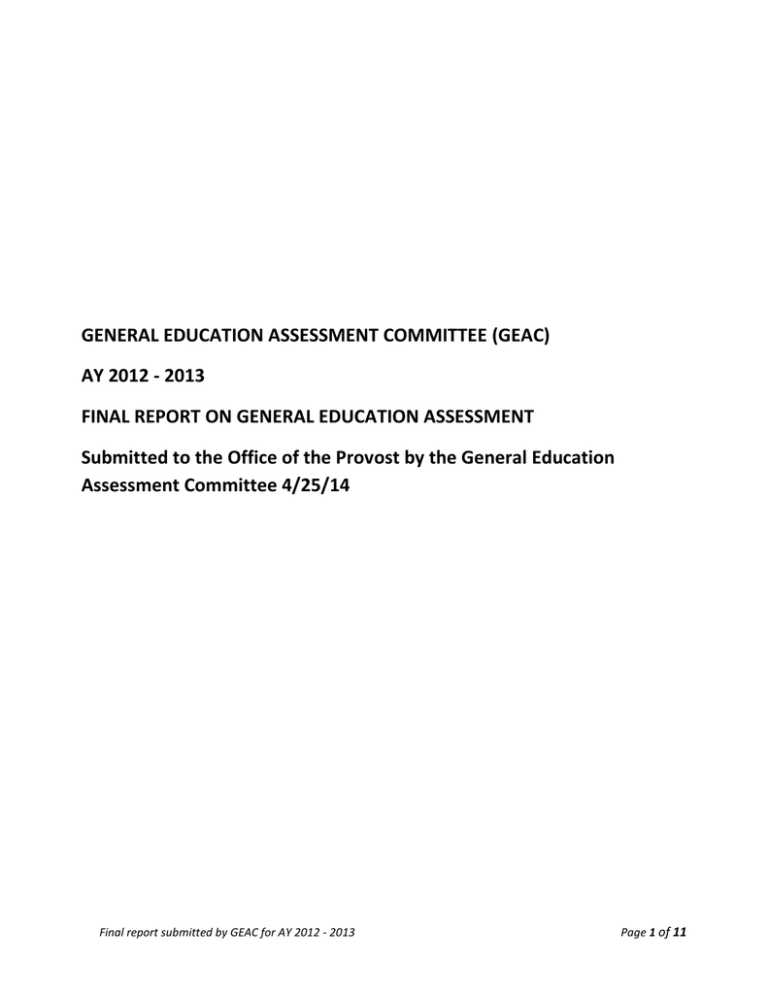
GENERAL EDUCATION ASSESSMENT COMMITTEE (GEAC) AY 2012 - 2013 FINAL REPORT ON GENERAL EDUCATION ASSESSMENT Submitted to the Office of the Provost by the General Education Assessment Committee 4/25/14 Final report submitted by GEAC for AY 2012 - 2013 Page 1 of 11 General Education Assessment Committee College of Business College of Education College of Liberal Arts & Sciences College of Visual & Performing Arts At-large Teaching Faculty At-large Teaching Faculty At-Large Teaching Faculty At-Large Non-Teaching Faculty Strategic Planning and Resources Committee Division of Administration and Finance Academic Dean Office of Assessment Student Government Board General Education Committee Clerical Support Dina Hayduk Nancy Cardenuto Varsha Pandya Valerie Trollinger Janice Gasker, Vice-Chair Mary Eicholtz Stephen Oross, Chair Krista Prock, Secretary William Donner Brent Penny William Dempsey Gil Clary Adelen Geiger Randy Schaeffer Kathi Malloy Academic Year 2012 – 2013 Final report submitted by GEAC for AY 2012 - 2013 Page 2 of 11 EXECUTIVE SUMMARY The General Education Assessment Committee is charged with directly assessing student learning outcomes for the KU General Education Program. In this second year of its existence, the committee continues to pilot the assessment and renewal plan that has been developed in accordance with its bylaws. This is the General Education Assessment Committee’s second annual report, based on the pilot assessment process, which analyzes data from AY12-13 relevant to Goal 2 of the new General Education Program: To develop an understanding of human cultures and the physical and natural world that is focused by engagement with big questions, both contemporary and enduring. The departmental data were provided by faculty volunteers who were trained by the GEAC members. Data were derived from course-embedded instruments addressing seven learning domains: Sciences, Mathematics, Social Sciences, Humanities, Histories, Languages, and Arts. Data were analyzed using grading rubrics based on the VALUE (Valid Assessment of Undergraduate Education) rubrics of the Association of American Colleges and Universities. Data from 13 courses, totaling 1,558 data points representing student academic performance, revealed some strengths and weaknesses in achievement of learning outcomes. Strengths in the general education program and its assessment process include the development of a culture of assessment on the campus, deriving from financial support from the institution. Activities supporting the development of a culture of assessment should continue. As observed in faculty comments, the process of assessment has generated ideas for course-based improvements in general education. Recommendations for future growth in the assessment process include the need for the development of benchmarks to measure success. Future measurement will need to include both curricular and cocurricular methods of general education delivery. Sampling will be enabled by the development of a curriculum map. In addition, sufficient future sampling methods will require the use of all faculty, not only those who volunteer to assess the students in their classes. No changes to the structure of the general education program or curriculum improvements are recommended at this time. The committee respectfully requests that resources continue to be allocated to the committee, particularly during this period of pilot testing the assessment process. Final report submitted by GEAC for AY 2012 - 2013 Page 3 of 11 I. INTRODUCTION The General Education Assessment Committee (GEAC) has been charged with collecting and analyzing assessment data on student learning outcomes emerging from Kutztown University’s General Education Program. The new General Education Program, in its second year of implementation, consists of three Learning Goals each containing a number of specific domains: Goal 1 - To cultivate intellectual and practical skills that are practiced extensively, across the curriculum, in the context of progressively more challenging problems, projects, and standards for performance, Goal 2 - To develop an understanding of human cultures and the physical and natural world that is focused by engagement with big questions, both contemporary and enduring, and, Goal 3 - To inculcate a sense of personal and social responsibility that is anchored through active involvement with diverse communities and real world challenges. The structural components that facilitate achieving the Learning Goals of this General Education Program include: The University Core Curriculum, containing 12 credits distributed across four areas: Oral Communication, Written Communication, Mathematics, and Wellness; University Distribution Requirements, containing 15 credits distributed across five areas: Natural Sciences, Humanities, Social Sciences, Arts, and Free Electives Competencies Across the Curriculum, thematic courses containing 21 credits distributed across five themes (9 credits in Writing Intensive; 3 credits each in Quantitative Literacy or Computer Intensive; Visual Literacy or Communication Intensive; Cultural Diversity; and Critical Thinking. Because the program consists of three goals, GEAC decided to work on a three-year assessment cycle. In the first year, the GEAC evaluated learning outcome data relevant to Goal 1; in the second year, learning outcome data relevant to Goal 2 will be evaluated; and in the third year, learning data relevant to Goal 3 will be evaluated. This report covers the second year of the first assessment cycle, and thus will address the assessment of student learning outcomes relevant to Goal 2. Each year GEAC is charged with submitting data-informed recommendations to the Division of Academic and Student Affairs and the Strategic Planning and Resources Committee. At the conclusion of each three-year cycle, GEAC will submit an additional report to the General Education Committee and the University Curriculum Committee. The purpose of each annual report is to make recommendations on the allocation of resources to improve the student learning outcomes of the General Education Program. The triennial report will also make recommendations on any potential structural changes required to improve the quality and effectiveness of the General Education Program. II. METHODS Final report submitted by GEAC for AY 2012 - 2013 Page 4 of 11 The General Education Assessment procedure approved for use at Kutztown University mandates that GEAC analyze data collected and aggregated by departments within which General Education courses are taught. To facilitate this effort, GEAC provided departments with standardized reporting templates that were adapted from the VALUE rubrics developed by the Association of American Colleges & Universities (AAC&U). These templates ask departments to report raw numbers of students demonstrating suggested behavioral achievement and/or quality of work on a descending level of performance, with “4” being the highest and “1” the lowest level of performance, with a “0” category for those failing to achieve the minimum expected level of performance. The templates also ask departments to summarize information about the type of assignment or evaluation instrument used and a description of their criterion of success. Additionally, a series of training workshops were conducted wherein the reporting templates were presented, instructions for use were provided, and instructors were able to ask questions or for more information in order to facilitate the use of the reporting templates. Instructors were free to propose their own methods of examining student learning, but the results were to be submitted using the approved reporting templates. With one exception, all departments reported direct measures of student learning. One department (ENG) elected to use the results of a student survey (an indirect measure of student learning) to create a starting point for further discussion on how the course may be meeting its objectives and on what objectives to focus when the assessment team conducts direct assessment of student work in future semesters. For Domain 2.1 Sciences, student performance was examined across three different courses (BIO 010, CHM 051,GEL 020) by using sets of specially designed questions (in one case, distributed across four exams; in the other cases, administered at the end of the course). The aggregated student data was reported using the template designed by GEAC for the assessment of Domain 2.1 Sciences. For Domain 2.2 Mathematics, every student taking the final examination for MAT 103 in the Fall semester of 2012, was asked to respond to two additional problems attached to the final examination. All of the students’ responses were collected and assessed on a four-point scale that related to the four performance levels outlined on the reporting templates. The departmental faculty assessed the student responses using their own rubric and reported the results using the template designed by GEAC for the assessment of Domain 2.2 Mathematics. For Domain 2.3 Social Sciences, student performance was examined by the use of two different methods. In one course (SWK 100) students were required to complete a group presentation focused on a specific population of interest (i.e. children & families; youth & schools; mental health) and that included a brief discussion of a specific topic discussed in a corresponding book chapter, as well as a class-engagement activity. Students were evaluated on their oral presentation, class activity, and the typed-outline that was provided to their peers. Two other courses (PSY 312, PSY 325) used sets of specifically designed questions (short-answer, matching, and multiple-choice) administered throughout the semester to assess student learning. The results were submitted to GEAC on the reporting template for Domain 2.3 Social Sciences. Final report submitted by GEAC for AY 2012 - 2013 Page 5 of 11 For Domain 2.4 ENG 010 students were presented with a survey that asked them to identify how well they felt they met each of the eight main course objectives using a 5-point Likert scale. The results were submitted to GEAC on the reporting template for Domain 2.4 Humanities. (The use of this indirect survey, which will be followed up in the following year with the use of a direct measure of student learning is part of the departments systematic effort to assess student learning and was communicated to GEAC early in the process. GEAC has no concerns about this plan and looks forward to the continued outstanding efforts of the Department of English to assess student learning.) For Domain 2.5 student performance was assessed during the HIS 025 Final exam using a set of multiple choice and true/false questions that tested criteria 1-3 from the reporting template for Domain 2.5 Histories. For Domain 2.6 in both SPA 103, SPA 104 students’ oral proficiency was assessed using the Computerized Oral Proficiency Instrument (COPI) created by the Center for Applied Linguistics (CAL). Performance on the COPI is rated using the ACTFL scale (American Council on the Teaching of Foreign Languages), the national standard for rating language proficiency. The data was then reported to the GEAC using the reporting template for Domain 2.6 Languages. For Domain 2.7, THE 015 course students were assessed on knowledge improvement using an instructor developed pre- and post-test method that involved a 10-question test administered during the first week of classes; the same questions were used as a post-test at the end of the semester. Performance levels were defined according to the IDEAS goals for the course set by theatre faculty, and are interpreted in the context of this single introductory course. In the MUS 010 course, student performance was assessed on critical listening skill improvement using a departmentally-developed pre- and post-test method. The pre and post-test used had been in use for 5 years by the faculty teaching MUS 010, however, a few changes were made this year to accommodate the criteria on the Domain 2.7 assessment reporting template. The test was comprised of 10 multi-faceted questions concerning samples of music selections (primarily instrumental). Ability to answer the questions depended not only on critical listening skills, but also ability to understand and use appropriate musical terminology to describe what they heard, and to also understand and address the historical, artistic, political, and sociological context of the pieces. Both of these courses reported the data to the GEAC using the reporting template for Domain 2.7 Arts. Having collected the assessment data from these courses, GEAC analyzed the data, considered recommendations proposed by the assessing departments, and drafted this report to be submitted to the Division of Academic and Student Affairs and the Strategic Planning and Resources Committee. III. SUMMARY OF ASSESSMENT REPORTS Core Requirement Percent Reported at Level 4 Percent Reported at Level 3 Final report submitted by GEAC for AY 2012 - 2013 Percent Reported at Level 2 Percent Reported at Level 1 Percent Reported at Level 0 Page 6 of 11 2.1. Sciences 2.2. Mathematics 2.3. Social sciences 2.4. Humanities 19.11% 6.96% 13.01% 29.89% 45.33% 39.24% 33.56% 58.62% 28.00% 21.52% 24.66% 10.34% 2.5. Histories n/a 80.23% 72.09%* 7.11% 26.58% 28.76% 0.77% 96.51%- facts 53.49%chronology 29.41% 0.44% 6.33% 0.00% 0.38% N=8 2.6. Languages 11.76% 29.41% 23.53% 5.90% 2.7. Arts 19.40% 41.50% 29.02% 9.47% 0.60% TOTAL 16.69% 41.28% 22.85% 17.02% 2.28% The data from the two domains highlighted by the gray table cells and italicized type (Humanities and Histories) were not included in the TOTAL calculations for two different reasons. The Humanities data derived from indirect data compiled from student self-reports of performance rather than direct evidence of student learning. The Histories data was direct evidence of student learning derived from performance on a final exam, however, the instructor decided that no students in an introductory course could possibly attain understanding representative of a Level 4 so student performance was identified using only Levels 1 to 3. ANALYSIS AND INTERPRETATION As this report was generated using data from Year 2 of the initial assessment cycle for Kutztown University’s new General Education Program, it is impossible to identify longitudinal trends. Rather these data should be seen as a starting point from which future trends may be derived. Nevertheless, the data presented to GEAC (obtained from a total of 1,558 data points representing student academic performance distributed across 13 courses), and the analyses compiled by the individual departments reveal strengths, as well as areas in which student performance may need to improve. Overall, the data and analyses obtained from our assessment of Goal 2 indicates that approximately 58% of the student sample performed at the highest two levels of understanding (level 3 and 4). What was also true was that many of the courses used to assess understanding of Goal 2 did not establish a formal benchmark target of success but rather for this first round simply identified the level at which students performed. The two approaches, establishing a benchmark or summarizing performance levels without establishing a benchmark, were described as appropriate in the training workshops. For Domain 2.1 Sciences, the approach to benchmarks varied wherein in one course the benchmark was stated to be performance at level 3 or 4 but no specific percentages were identified, and two courses where no benchmarks were set, student performance levels were just identified. The data indicated (a) 70% of students at levels 3 or 4, (b) 47% of students at levels 3 or 4, and (c) 70% at levels 3 or 4. For Domain 2.2 Mathematics, benchmarks were stated to be performing at Level 3 or Level 4 but no specific percentages were identified. The date indicated that 52.2% of students performed at levels 3 or 4. Final report submitted by GEAC for AY 2012 - 2013 Page 7 of 11 IV. For Domain 2.3 Social Sciences, no benchmarks were set, student performance levels were identified at 46% of students performing at levels 3 or 4. However, it was noted that 89% of students in the 100 level course were at level 3 or 4 whereas approximately 30% percentage of students in the two 300 level courses were at levels 3 or 4. For Domain 2.4 Humanities no benchmarks were set, the indirect assessment of student performance was used to help begin establishing a baseline for future assessment of student learning that will use direct evidence of student learning. For Domain 2.5 Histories benchmarks levels of success were set at 80% of students reaching level 1 and 70% of students reaching levels 2 and 3. The results indicated these benchmarks were met with the one exception that students had more difficulty with the chronology of historical events than with basic factual information. For Domain 2.6 Languages the benchmarks for success were established by referring to the ACTFL scale (American Council on the Teaching of Foreign Languages) which is the national standard for rating language proficiency. For Spanish 103, student performance at Level 2 (NM) would be satisfactory. For Spanish 104, student performance at Level 3 (NH) would be satisfactory. For SPA 103, 63% of the students achieved the satisfactory level with 25% of the students exceeding the satisfactory level. For SPA 104, 71% of the students achieved the satisfactory level with 36% of the students exceeding the satisfactory level. For Domain 2.7 Arts no benchmarks were established, however, values on pre-post test allowed for a determination of the value-added by participation in these courses. This is an approach often useful when there is an understanding of the novice level at which most students enter their “general education” courses and, therefore, the expectation is that the students will become experts in one course. GEAC RECOMMENDATIONS GEAC has organized our recommendations under three headings, addressing proposed changes to the General Education Program, the allocation of resources for the continuous improvement of General Education, and actions by which we can improve the process by which General Education is assessed at Kutztown University. A. Structural and/or Curricular Improvements to the General Education Program i. There are insufficient data at this point to recommend structural changes to the General Education Program; however, one issue becoming evident concerns the frequency and manner in which general education learning goals are introduced and reinforced. For example, one volunteer noted that “I don’t think a single class, or even two classes, can help a non-scientific thinker achieve Performance Level 4, nor should it be expected to.” Another volunteer noted that his upper division courses have no “real” prerequisite courses (that is, that the prerequisite course rarely, if ever, touch on the topics addressed in the 300 level course) to build to 300 level understanding of material. Therefore, what is appropriate level of performance to expect from students? Final report submitted by GEAC for AY 2012 - 2013 Page 8 of 11 We believe that the establishment of the general education curriculum map will help provide a basis to begin engaging in discussions related to these points as they relate to helping students attain success with the goals of the General Education Program. ii. The GEAC also wishes to highlight that both curricular and co-curricular experiences assist students in achieving mastery of the General Education learning goals. For this reason, we will need to initiate a campus-wide discussion to consider how to expand assessment efforts to explore the effectiveness of all means of advancing student learning as it relates to our General Education Program. iii. Even with our most recent efforts we had a limited number of volunteers step forward, we had some volunteers begin and then fail to complete their reports, and we had other volunteers use the reporting templates in a different manner than intended. Therefore, the GEAC also recommends that we need to take further steps to formalize and increase our training efforts related to the use of reporting templates, providing mentors or guides to help instructors throughout data collection and reporting efforts, and establishing administrative consequences for those who fail to participate in assessment efforts. To accomplish this goal, however, we will need to work carefully with the Office of Assessment and the Division of Academic and Student Affairs as we are asking for major commitments of time on the part of the GEAC membership when most of the members do not receive any relief from their teaching, scholarship, or other service activities. iv. Most volunteers used the assessment data collected to suggest methods by which their particular course could be improved (which would obviously, also improve the General Education program). We suspect that most, if not all, faculty do this and note that the collection of this information in the GEAC reports may eventually provide a means of sharing ideas among instructors. This documentation of course revisions driven by assessment data is part of “closing the loop” and provides documentation that we were previously lacking. B. Resource Allocation to Improve General Education It is not lost on the GEAC that the initial pilot projects, instrument development, faculty training, faculty stipends, support for the January conference/workshops on Assessment and General Education, and the support for participation in the AAC&U Summer Institutes for General Education and Assessment were funded through the Office of Assessment and the Division of Academic and Student Affairs. GEAC commends the Division of Academic and Student Affairs for funding these efforts and encourages them to continue supporting these endeavors as we believe there is sufficient data to show the advance in the culture of assessment across campus is directly tied to this support. C. Improvements to Assessment Process i. As discussed in earlier sections in this report, and in the Year 1 report, GEAC has also concluded that work needs to be done to improve the process used to assess student learning outcomes of the General Education Program. In particular we believe that we must address how benchmarks are established as a means of outlining a more Final report submitted by GEAC for AY 2012 - 2013 Page 9 of 11 systematic approach to establishing benchmarks and for calibration of expectations within departments, colleges, and the university as a whole. a. One concern, for example, centers on the sometimes arbitrary nature by which benchmarks are defined. It is understandable that departments involved in assessing student performance want to know whether or not students are doing well. Some departments, in this year’s effort the Modern Language Studies department, are able to refer to national organizations who have established guidelines and benchmarks. Other departments, however, do not have these resources and are attempting to define the benchmarks they believe are appropriate with relatively little assistance. As a result, the benchmarks may differ across departments. The GEAC believes it appropriate to consider how benchmarks are established, and would like to see a more systematic approach to establishing benchmarks and for calibration of expectations within departments, colleges, and the university as a whole. b. A related concern centers on the distinctions between courses at the various levels (e.g., 100 v 200 v 300). When benchmarks are established it is clearly evident that the benchmarks are made relative to the General Education Goals. That is, we expect students to improve in developing mastery of the goals; however, we do not usually expect students to exhibit mastery in their initial introductions to course. Given that these initial introductions are usually made in the 100 level courses we might expect that the benchmarks of success in 100 level courses would vary relative to the benchmarks of success in 200 or 300 level courses. At this time, our curriculum map simply indicates a link between courses and goals and domains. We do not have a map that indicates when a particular goal may be “introduced” or “practiced/reinforced” or when we might expect to see “mastery.” We cannot clearly indicate the path by which varying course build upon one another. The GEAC believe that we can begin to help ourselves by engaging in discussions about developmental progress from 100 to 200 to 300 level courses. We recommend that training and professional development occur in benchmarking. c. Additionally, a strategic comparison of 100 v 200 v 300 courses might also allow us to examine the “value—added” by an education at Kutztown University. Some value added information can be obtained within courses by the use of pre-post test designs (see, e.g., efforts in Domain 2.7) but these are course specific gains. We believe we may be able to look at valueadded at a program level if we expand our curriculum mapping efforts and engage in a thoughtful consideration of the developmental progression in student learning across course level designations. We recommend that training and professional development occur in enhanced curriculum mapping. Final report submitted by GEAC for AY 2012 - 2013 Page 10 of 11 d. For future sampling efforts, it is imperative that a University-wide curriculum map be developed in which courses that deliver general education content specific to each of the program goals and objectives are identified and available for assessment. Final report submitted by GEAC for AY 2012 - 2013 Page 11 of 11
